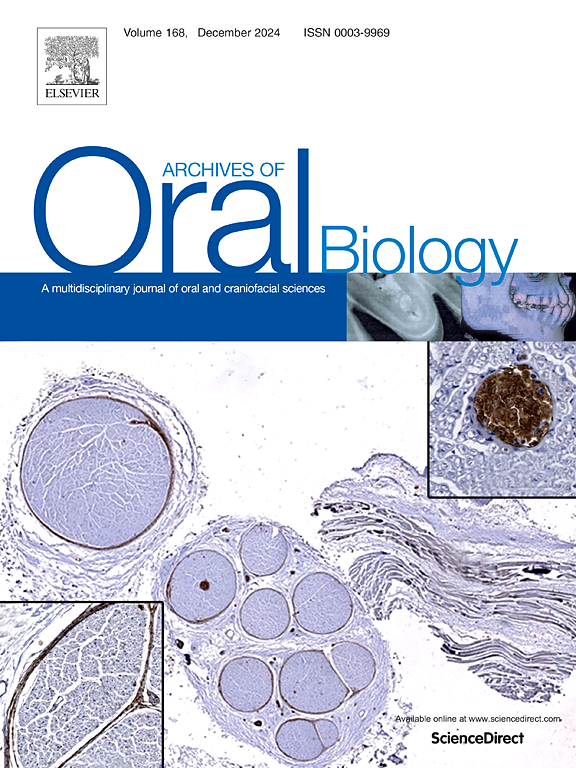在加拿大西部的青少年中,嵌塞的风险随着第三磨牙发育的后期逐年显著增加
IF 2.2
4区 医学
Q2 DENTISTRY, ORAL SURGERY & MEDICINE
引用次数: 0
摘要
目的:第三磨牙(M3)嵌塞每年影响全球数百万患者,但其病因尚不清楚。在这里,我们研究了一个未被充分探索的嵌塞风险因素,比较了M3发展的后期和早期,以计算嵌塞风险,作为临床医生的资源。设计采用回顾性CBCT扫描和正骨断层扫描研究了年龄6-24岁的99名加拿大西部人(57名女性,42名男性)共324个M3区域(上颌157个,下颌骨167个)。在较早的时间点T1收集M3隐窝、冠和根发育阶段数据,然后测试与较晚时间点T2记录的M3喷发状态数据的相关性。该测试使用广义线性混合和估计模型来探索M3发育阶段与喷发状态之间的关系,并测量可能性、功能性喷发和撞击风险(α水平=0.05)。结果统计上,T1期M3发育较晚的每一年M3在T2期的撞击风险几乎增加一倍。早期发育的M3s有最小的撞击风险,低至5% %。这一结果在上下颌骨和两性中是相同的。受影响的M3s发育延迟是由于发育开始较晚,而不是发育速度较慢。结论发育迟发的M3s更易受到影响。建议从青春期前开始对M3发育进行临床监测。由于早期发育的M3s存在最小的影响风险,因此不太可能需要预防性切除。这项工作为磨牙牙形成提供了基础的新见解,同时提供了实用的信息,以帮助制定管理发展中的M3s患者的指南。本文章由计算机程序翻译,如有差异,请以英文原文为准。
Impaction risk increases significantly with each year of late third molar development in Western Canadian youths
Objective
Third molar (M3) impaction affects millions of patients annually worldwide yet its etiology is unclear. Here we study an underexplored risk factor for impaction, later versus earlier M3 development, towards calculating impaction risk as a resource for clinicians.
Design
A total of 324 M3 areas (157 maxillary, 167 mandibular) were studied using retrospective CBCT scans and orthopantomograms of 99 Western Canadians (57 females, 42 males) aged 6–24 years. M3 crypt, crown and root development stage data were collected at an earlier timepoint T1 and then tested for association with M3 eruption status data documented at a later timepoint T2. This testing used Generalized Linear Mixed and Estimation modeling to explore relationships between M3 development stage and eruption status, and measure likelihood of versus functional emergence versus impaction risk (alpha level=0.05).
Results
Statistically, each year of late M3 development at T1 nearly doubled an M3’s risk of impaction at T2. Early-developing M3s had minimal impaction risk, as low as 5 %. This outcome was equivalent in upper and lower jaws and both sexes. Impacted M3s’ development was delayed due to later developmental onset, not to slower developmental rate.
Conclusions
Late-developing M3s are statistically more likely to become impacted. Clinical monitoring of M3 development from preadolescence is suggested. As early-developing M3s present minimal impaction risk, they are less likely to require prophylactic removal. This work provides foundational new insights into molar odontogenesis alongside practical information to help develop guidelines for managing patients with developing M3s.
求助全文
通过发布文献求助,成功后即可免费获取论文全文。
去求助
来源期刊

Archives of oral biology
医学-牙科与口腔外科
CiteScore
5.10
自引率
3.30%
发文量
177
审稿时长
26 days
期刊介绍:
Archives of Oral Biology is an international journal which aims to publish papers of the highest scientific quality in the oral and craniofacial sciences. The journal is particularly interested in research which advances knowledge in the mechanisms of craniofacial development and disease, including:
Cell and molecular biology
Molecular genetics
Immunology
Pathogenesis
Cellular microbiology
Embryology
Syndromology
Forensic dentistry
 求助内容:
求助内容: 应助结果提醒方式:
应助结果提醒方式:


